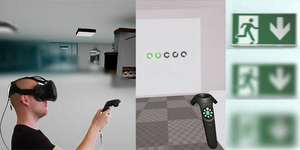Information
- Publication Type: PhD-Thesis
- Workgroup(s)/Project(s):
- Date: November 2020
- Date (Start): April 2016
- Date (End): October 2020
- TU Wien Library:
- Second Supervisor: Georg Suter
- Open Access: yes
- 1st Reviewer: Prof. Dr. Mark Billinghurst
- 2nd Reviewer: Prof. Dr. Mark Billinghurst
- Rigorosum: 30. November 2020
- First Supervisor: Michael Wimmer
Abstract
There are at least 2.2 billion people affected by vision impairments worldwide, and the number of people suffering from common eye diseases like cataracts, diabetic retinopathy, glaucoma or macular degeneration, which show a higher prevalence with age, is expected to rise in the years to come, due to factors like aging of the population.Medical publications, ophthalmologists and patients can give some insight into the effects of vision impairments, but for people with normal eyesight (even medical personnel) it is often hard to grasp how certain eye diseases can affect perception. We need to understand and quantify the effects of vision impairments on perception, to design cities, buildings, or lighting systems that are accessible for people with vision impairments. Conducting studies on vision impairments in the real world is challenging, because it requires a large number of participants with exactly the same type of impairment. Such a sample group is often hard or even impossible to find, since not every symptom can be assessed precisely and the same eye disease can be experienced very differently between affected people.
In this thesis, we address these issues by presenting a system and a methodology to simulate vision impairments, such as refractive errors, cataracts, cornea disease, and age-related macular degeneration in virtual reality (VR) and augmented reality (AR), which allows us to conduct user studies in VR or AR with people with healthy eyesight and graphically simulated vision impairments. We present a calibration technique that allows us to calibrate individual simulated symptoms to the same level of severity for every user, taking hardware constraints as well as vision capabilities of users into account.
We measured the influence of simulated reduced visual acuity on maximum recognition distances of signage in a VR study and showed that current international standards and norms do not sufficiently consider people with vision impairments. In a second study, featuring our medically based cataract simulations in VR, we found that different lighting systems can positively or negatively affect the perception of people with cataracts. We improved and extended our cataract simulation to video–see-through AR and evaluated and adjusted each simulated symptom together with cataract patients in a pilot study, showing the flexibility and potential of our approach. In future work we plan to include further vision impairments and open source our software, so it can be used for architects and lighting designers to test their designs for accessibility, for training of medical personnel, and to increase empathy for people with vision impairments. This way, we hope to contribute to making this world more inclusive for everyone.
Additional Files and Images
Weblinks
BibTeX
@phdthesis{KROESL-2020-SVI,
title = "Simulating Vision Impairments in Virtual and Augmented
Reality",
author = "Katharina Kr\"{o}sl",
year = "2020",
abstract = "There are at least 2.2 billion people affected by vision
impairments worldwide, and the number of people suffering
from common eye diseases like cataracts, diabetic
retinopathy, glaucoma or macular degeneration, which show a
higher prevalence with age, is expected to rise in the years
to come, due to factors like aging of the population.
Medical publications, ophthalmologists and patients can give
some insight into the effects of vision impairments, but for
people with normal eyesight (even medical personnel) it is
often hard to grasp how certain eye diseases can affect
perception. We need to understand and quantify the effects
of vision impairments on perception, to design cities,
buildings, or lighting systems that are accessible for
people with vision impairments. Conducting studies on vision
impairments in the real world is challenging, because it
requires a large number of participants with exactly the
same type of impairment. Such a sample group is often hard
or even impossible to find, since not every symptom can be
assessed precisely and the same eye disease can be
experienced very differently between affected people. In
this thesis, we address these issues by presenting a system
and a methodology to simulate vision impairments, such as
refractive errors, cataracts, cornea disease, and
age-related macular degeneration in virtual reality (VR) and
augmented reality (AR), which allows us to conduct user
studies in VR or AR with people with healthy eyesight and
graphically simulated vision impairments. We present a
calibration technique that allows us to calibrate individual
simulated symptoms to the same level of severity for every
user, taking hardware constraints as well as vision
capabilities of users into account. We measured the
influence of simulated reduced visual acuity on maximum
recognition distances of signage in a VR study and showed
that current international standards and norms do not
sufficiently consider people with vision impairments. In a
second study, featuring our medically based cataract
simulations in VR, we found that different lighting systems
can positively or negatively affect the perception of people
with cataracts. We improved and extended our cataract
simulation to video–see-through AR and evaluated and
adjusted each simulated symptom together with cataract
patients in a pilot study, showing the flexibility and
potential of our approach. In future work we plan to include
further vision impairments and open source our software, so
it can be used for architects and lighting designers to test
their designs for accessibility, for training of medical
personnel, and to increase empathy for people with vision
impairments. This way, we hope to contribute to making this
world more inclusive for everyone. ",
month = nov,
address = "Favoritenstrasse 9-11/E193-02, A-1040 Vienna, Austria",
school = "Research Unit of Computer Graphics, Institute of Visual
Computing and Human-Centered Technology, Faculty of
Informatics, TU Wien ",
URL = "https://www.cg.tuwien.ac.at/research/publications/2020/KROESL-2020-SVI/",
}


 thesis
thesis
